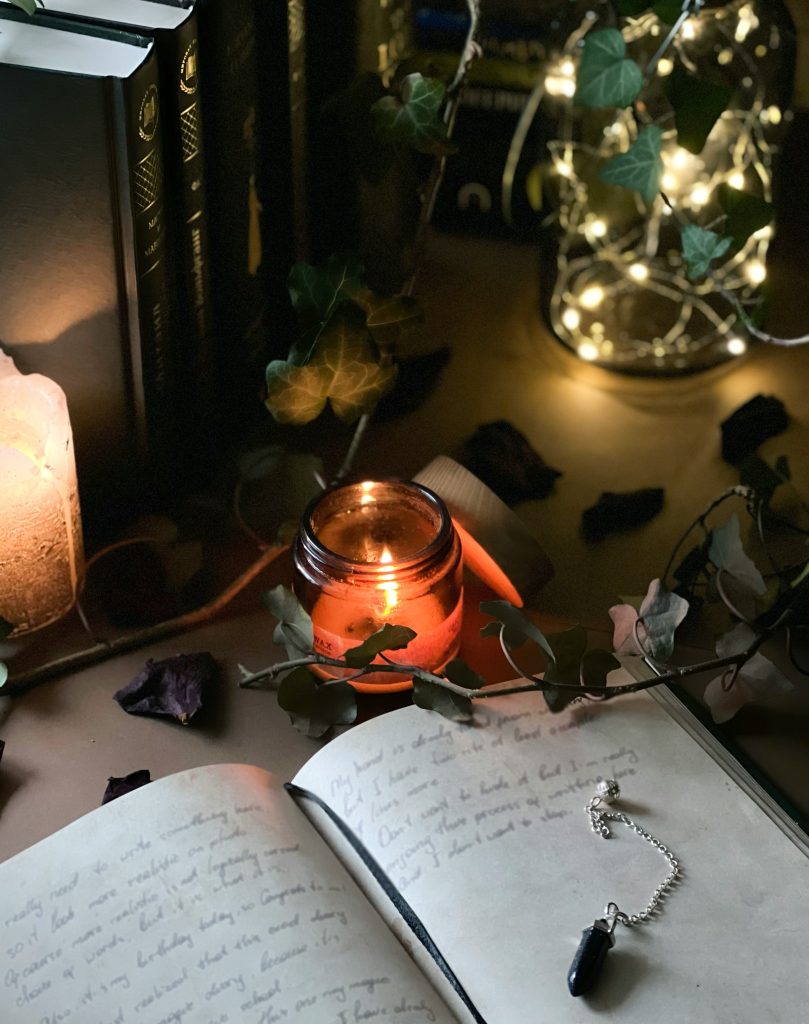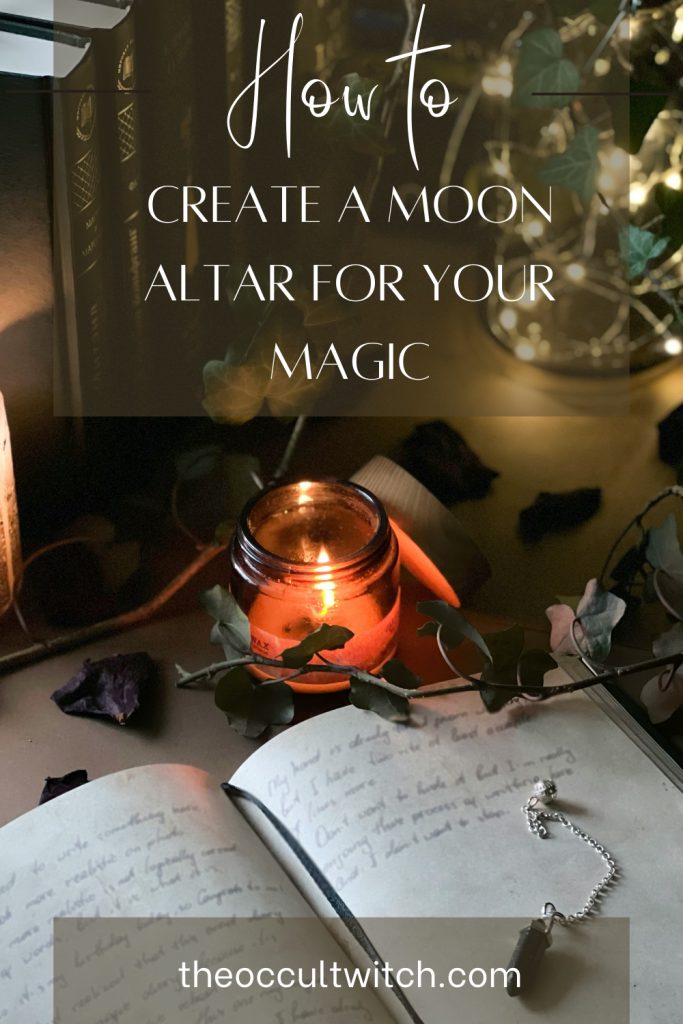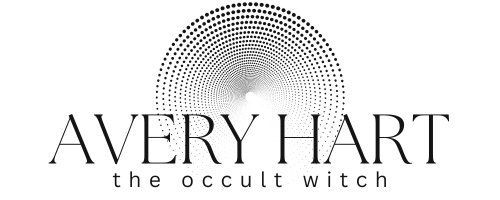Moon altars are sacred, magical spaces that you create to honor and harness the different energies of the lunar cycle. Like all altars, a moon altar is a place where you can focus and direct energy through your witchcraft. You can perform spells, meditations, or full moon rituals at your moon altar or simply send your gratitude up to the moon for shining down on you night after night.

I want to start by saying there’s no wrong way to make a moon altar. You can set it up inside or outside, elaborate or simple, and everything in between. Though there are certain magical tools that you can include on your altar to add power and focus, there’s no specific set of directions to set up a moon altar. That means you can get as creative as you like when setting up your moon altar. As long as your altar feels sacred, special, and powerful to you, you’re good to go!
Types Of Moon Altars
Traveling Moon Altars
You can take your witchcraft with you wherever you go! A popular way to do this is to use a small drawstring bag, an altar cloth tied up to make a pouch, or an empty mint tin to store the magical tools for your moon altar.
Put travel-friendly magical tools in your altar containers such as small crystals, tarot cards, birthday candles, colored ribbon (for knot spells or color magic), or any other objects that you feel belong in your moon altar. These altars are great if you love to go hiking and want to set up an altar outside under the moon.
Stationary Moon Altars
This is what people typically think of when it comes to altars. These are the altars that are set up on a dedicated space in your home or outdoor area. Some witches will keep these altars up all the time; other witches will keep their tools in a box or drawer when not in use.
These altars are great because you can deck them out with all kinds of trinkets and tools and not have to worry about losing or damaging these items during travel.
Mental Altars
This is a more unconventional altar option that might appeal to you if you love visualizing. You can actually make a moon altar using only your mind. In your mind’s eye, visualize a sacred space in any location in the world and include any magical tools you’d like to use on your moon altar.
Visualizing an altar is a great meditation on its own or combined with other moon rituals like taking a moon bath (in lunar light) or performing divination magic under the moon. If you don’t have the time or energy to set up an altar, you can sit outside under the moon or by a window and simply visualize your moon altar.
Representing The Moon On Your Altar
When you’re choosing objects for your moon altar, you’ll want to include at least one magical tool to represent the moon. Get creative here and use whatever tools you associate with the moon. This is your magical practice, and you can choose anything you’d like.
If you’re looking for suggestions, here are some different tools and methods I’ve used to represent the moon on my altar:
Crystals to Represent the Moon:
- Selenite
- Moonstone (Some witches believe that moonstone is best used during the waxing moon phase because all the other phases of the moon deplete or dilute its energy.)
- Clear quartz
- Labradorite
- Opal
- Pearl (This isn’t technically a crystal. It’s more often considered a gemstone, but it’ve included it here anyway.)
- Any white crystals
- Polished circular or spherical crystals
Place a crystal to represent the moon in the center of your altar. Some witches like to write their intention on a piece of paper and place it under that stone. It’s symbolic of a witch sending the intention up to the moon and releasing it into the universe where it can manifest.
Plants, Flowers, and Herbs to Represent the Moon:
- Jasmine
- Dandelion
- Any white or pale blue flower
If you use herbs or plants to represent the moon, you can arrange them in the shape of whatever phase the moon is currently in—a circle for the full moon or a crescent shape for the waxing or waning moons.
If you’re using flowers on your altar, you can coordinate the “phase” of your flowers with the phases of the moon. For example, you can represent new moon energy with flower seeds or flower buds. Waxing moon energy can be represented with flowers that are beginning to bloom. You can represent full moon energy with flowers in full bloom. Waning moon energy can be represented with flower petals. You take them off flowers that are wilting and sprinkle them on your altar.
Candles to Represent the Moon:
- Any kind of candle can represent the moon because candles are tools that provide light.
- White tea lights are ideal for moon altars because they’re inexpensive, and they’re round like the moon. They also make black tea lights which are nice to use during the new moon.
Use your moon candle for spells or divination methods like scrying and candle gazing. You can burn intentions with your moon candle if you like.
You can also try lighting your candle for the waxing moon and full moon phases and keeping your candle unlit for the waning moon and new moon phases.
Magical Containers to Represent the Moon:
- Cauldron
- Cups or glasses
- Chalices
- Jars
These tools are all related to the moon because they are usually round and they can hold water. The moon is associated with water because it affects the ocean tides.
You can use any of these containers to represent the moon on your altar. Some witches will fill these containers with water or a potion before placing them on their altar. Other witches will burn incense, bay leaves or journal pages in these containers during a moon spell. Make sure your container is fireproof and use proper fire safety when doing this kind of magic!
If your moon altar is outside, the current energy of the moon will charge the liquid in the container. You can then use that liquid for spells or for elixirs.
Unusual Tools to Represent the Moon:
You don’t always have to use traditional magical tools to represent the moon on your moon altar. Anything you have on hand that reminds you of the moon or the moon’s energy can be just the thing you need on your altar!
An Egg—It’s shaped like a full moon, and it’s perfect if you plan on performing an egg spell at your lunar altar.
A Marshmallow—Again, this looks a bit like a full moon. It’s fun to drop a marshmallow into a warm potion and watch it dissolve. This can be symbolic of how your energy the moon’s energy merge together when you’re performing magic at your moon altar.
Salt or Sugar—Place a bit of salt or sugar in a bowl and use that to represent the moon on your altar. Some witches like to write their intentions on strips of paper and bury them in the salt or sugar. This is a way to send your intention up to the moon and into the universe.
Ribbon—Arrange the ribbon in the shape of the current moon phase. Choose a ribbon in a white or pale blue color, or whatever color you feel would best represent the moon.
A Mirror—Place a mirror in the center of your moon altar to represent the moon. Any mirror is fine, but circular mirrors are ideal for moon altars. If your moon altar is outside, set up your mirror so it is reflecting the moon.
Representing The Four Moon Phases
If you want to make your moon altar more specific to the current phase of the moon, you can decorate your moon altar with things that represent the energy of the moon’s current phase.
Most witches break the lunar cycle down into four phases—new moon, waxing moon, full moon, and waning moon. There are other ways to separate the different phases, but for this article, we’ll use the four-phase system.
New Moon: This moon is usually associated with the energy of planning and rest, new beginnings, and fresh starts. A labradorite crystal or a cup of chamomile tea are two examples of objects that embody new moon energy.
Waxing Moon: This moon is typically associated with growth, expansion, action, and progress. A clear quartz crystal or a potted plant are two objects that embody waxing moon energy.
Full Moon: This phase is almost always thought to hold the energy of abundance, celebration, and a time of increased manifesting power. Citrine crystals, pyrite crystals, fruit, and coins are all objects that work beautifully on a full moon altar.
Waning Moon: This moon phase is usually recognized as a time of introspection, release, and spiritual healing. Smoky quartz or the Four of Swords tarot card embody the energy of the waning moon.
Other Objects You Can Include On Your Moon Altar
Once you’ve selected an item to represent the moon, and maybe picked a few items to tap into the energy of the current moon phase, you can add any other magical items that will support your specific intentions. This includes any colors, tools, or ingredients you’d normally use when performing your spell.
Set these objects on your moon altar just as you would on any altar. If you normally place a purple candle, a piece of amethyst, and the High Priestess tarot card on your altar for a spiritual wisdom spell, put those things on the altar right alongside your moon objects.
For best results, try to match your intentions to the energy of the current moon phase. As an example, financial abundance spells are perfect for the waxing moon phase, and banishing spells work well with waning moon energy.
Additional Tips For Your Moon Altar
- Arrange the objects in a way that is most visually or energetically pleasing to you. You don’t have to place things in a specific position on your altar.
- Sometimes you’ll want to have many objects on your moon altar. Other times, you’ll just have one or two. This is a personal choice that you can make in your craft.
- You can represent different energies or deities on your moon altar. For example, I’ll often use objects to represent the elements of earth, water, fire, and air on my moon altar. Then in the center, I’ll place one object to represent the moon.
- Invite the energy of the moon to be present when you are performing magic at your altar. Call on the moon the way you would any other element or deity. I’ll say something like, “I call on the energy of the new moon. Bring your energy of new beginnings and blank slates so I can see my current obstacle with fresh eyes.”
Struggling with your magic?
Take the Quiz to Discover Your #1 Witchcraft Obstacle

Updated on December 7, 2024 by Avery Hart




This is wonderful. Thank you for sharing. And I LOVE your ideas for alternatives, especially the marshmallow!!